Summary: An ultimately large,
flat-topped pinenut tree that bears large cones with large pinenuts of
unsurpassed nutritional value. It is tolerant of a wide variety of soil
conditions, as long as drainage is good. Time from seedling to first
cones is around ten years (but may be sooner). It is easily available
in New Zealand. Grafted plants of superior varieties are not available.
It is probably partially self fertile, setting fewer seeds in the
absence of another tree nearby. It may be possible to graft this
species to a Pinus maximartinezii
rootstock, as a possible size-reducing rootstock, although this is speculative.
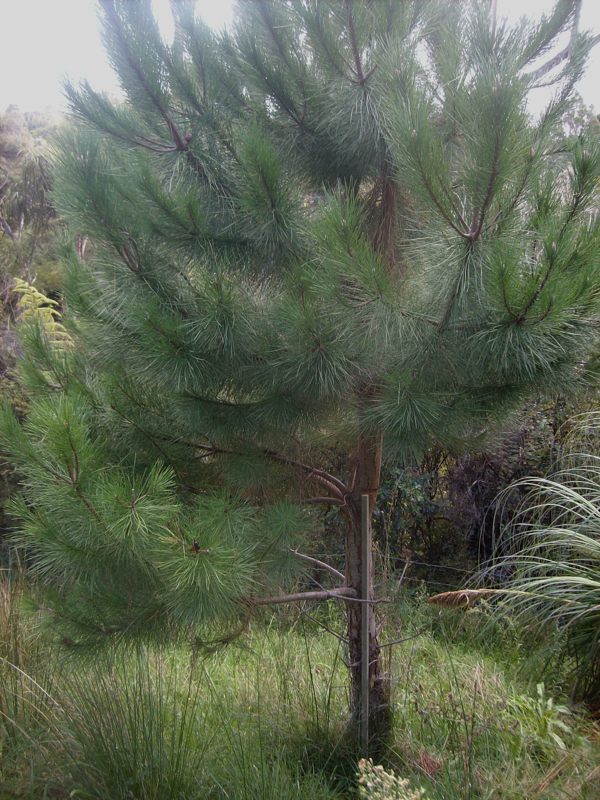
Young tree, planted 2001 at Helensville.

Young tree, planted 2001 at Helensville.
Pinus pinea is native to the Mediterranean region, probably originally Spain and Portugal. The trees are drought hardy, and have been grown for centuries for their relatively large edible seeds. The tree is initially bushy and globular, but as is ages it sheds its lower branches and the crown spreads into a distinctive 'umbrella' form. Thus one of its names 'Umbrella pine'. It is also called the stone pine, and the Italian stone pine.
It ultimately forms a big tree, from 12 to 35 metres high.
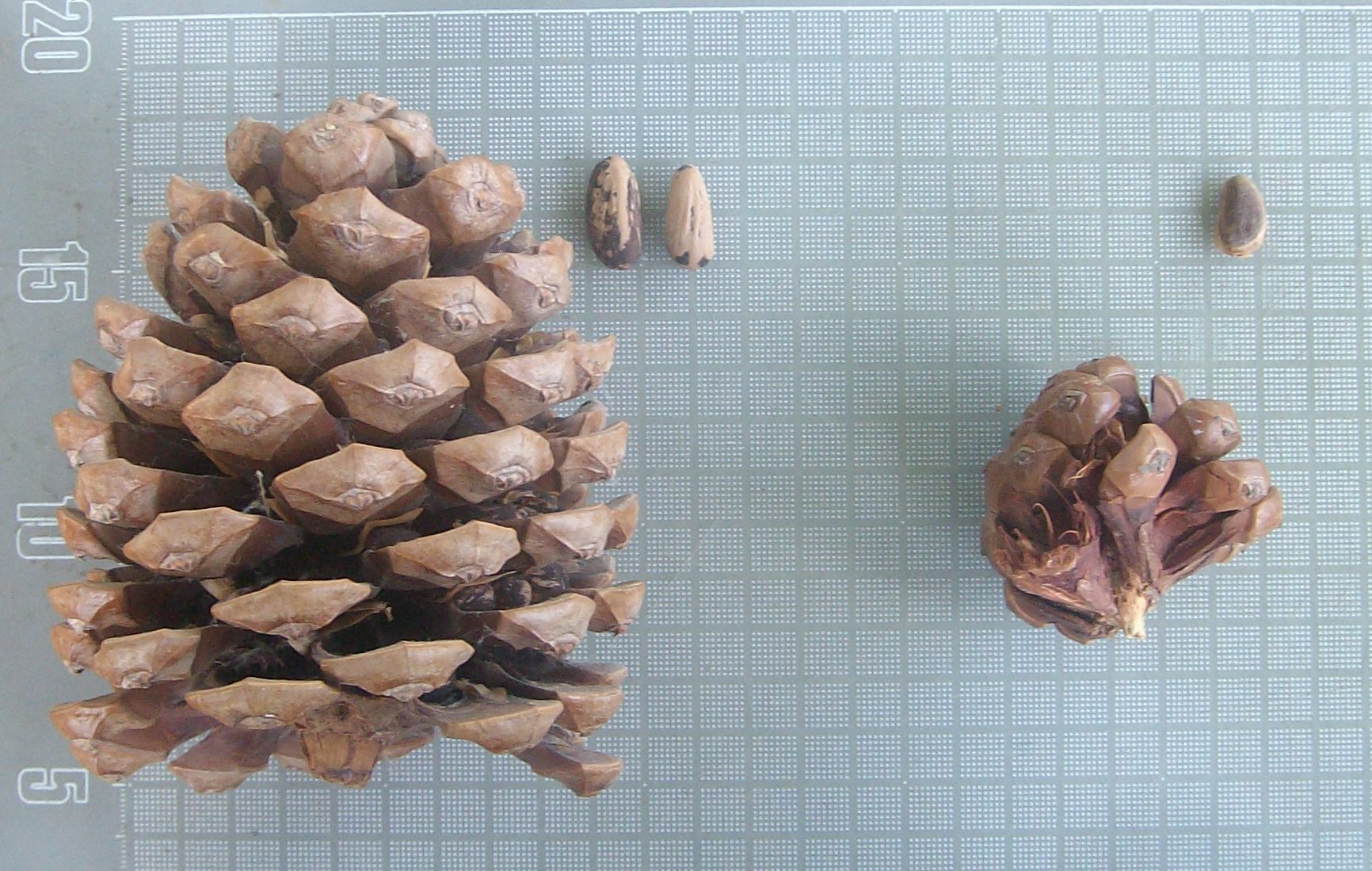 The
seeds (pine nuts) are called piñones in Spanish and pinoli or
pignoli in Italian. The cones are quite large, and have 2
seeds per scale. This species gives a 'premium pinenut', with an
excellent flavour and high protein content (around 33%,similar to
soybeans). In 1999, about 60% of all pinenut on the market, from all
species of pinenut and all countries, were Pinus pinea seeds. Since then,
Chinese (and Russian) supply has increased dramatically, as wild stands
of east Eurasian pine species were exploited for timber.
The
seeds (pine nuts) are called piñones in Spanish and pinoli or
pignoli in Italian. The cones are quite large, and have 2
seeds per scale. This species gives a 'premium pinenut', with an
excellent flavour and high protein content (around 33%,similar to
soybeans). In 1999, about 60% of all pinenut on the market, from all
species of pinenut and all countries, were Pinus pinea seeds. Since then,
Chinese (and Russian) supply has increased dramatically, as wild stands
of east Eurasian pine species were exploited for timber. The bulk of the world supply is now from this region. Pinenuts from China are cheaper, but may contain a mix of species (chiefly Pinus koraiensis), including Pinus armandii, which has a question over it regarding it having a lingering bitter or metallic taste. Indeed, there is a move in the Mediterranean countries to have country of origin labeling for the high quality Pinus pinea nuts.
Left - Pinus pinea cone and pinenuts (not removed from the shell). Right - unknown roadside tree, probably a Eurasian species.
"The production varies in cycles of 2-6
years. The number of pinecones per tree is a function of tree diameter
and the average yield is about 15-22 kg of pine nuts per 100 kg of
cones. Collection takes place by men who climb on trees and gather the
cones by hand or with a special tool. Each worker can collect about 400
to 600 cones per day. ...Before reaching the market the external hard
cover of the pine seeds is removed by the use of special machines, a
process that adds extra cost to the product."
- Moussouris and Regato (1999)
- Moussouris and Regato (1999)
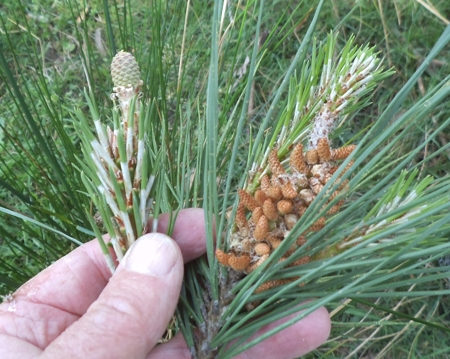
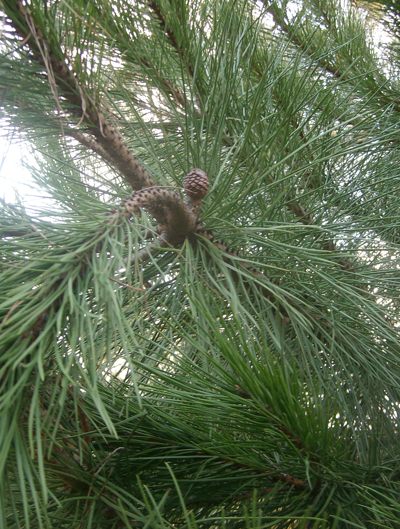 Growing season one
Growing season oneIn autumn (march to may) some cells form microscopic male and female flowering initials at the tip of the pre-formed buds on the very tip of that summers branches.
As spring starts, and the terminal buds from last season begin to swell and elongate, the 'flower' buds form tiny female conelets (which produce ovules and ultimately seed). The oval female 'conelet' becomes visible, at which time it is about pea size. Female conelets are initially whitish, and form on the tips of the strongest and most vigorous shoots. There are usually 1 or 2 conelets, and in some exceptional individuals, 3.
Spring is also when separate pollen bearing structures appear, in orangey-brown clusters at the tips of branches. Pollen is normally released about october, and the tiny female conelets briefly open their scales to receive it.
| Female
conelet and male pollen
structure in the spring of its first season of
growth
Marble sized Pinus pinea conelet, autumn of its first seasons growth |
purposefully pollenizing #pinus_pinea - prolific pollen puffing prevents poor pine production. pic.twitter.com/NT59J34Fg4
— Laurie Meadows (@Laurie_Meadows) October 23, 2018
Pollination takes place as long as the males are shedding pollen when the female conelet's scales are open. The conelets close their scales again, and won't open them again until final cone maturity. If the conelet opening does not co-incide with pollen shed, the incipient cone dies and falls off. Researchers suspect the pollen has a hormonal effect, preventing the tiny conelet from falling.
The pollinated pollinated conelets growth is slow over summer and autumn. It turns from whitish to a muted brown over summer, and by winter, purple-brown. At the stage the conelets are only about large marble size.
Growing season two
In spring, fertilized conelets start to swell the seeds within the cone, and the cones grow steadily over the summer and autumn to about tennis-ball size, and turn from brown to bright green by winter.
Growing season three
The green winter cones continue to grow over their third and final spring and summer. By autumn the cones are full size. The cone colour changes color once again, becoming nut-brown brown over winter. At this point, they are fully mature.
The cones are harvested late winter or spring when the scales have yet to open. In summer, remaining cones fall from the tree, and summers heat causes them to open up and drop their seed.
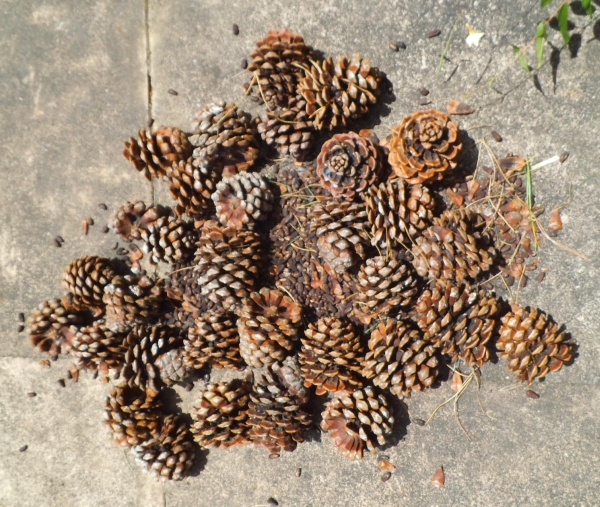
It takes quite a bit of work to shake and bash the seeds out of the cones
Time (and labour) intensive. That's why ponenuts are expensive.
Culture
Pinus pinea plants are readily available from New Zealand nurseries. These plants are all grown from seed. They have the advantage of producing a few cones, at least, relatively early - from ten years, or even earlier. And each cone can contain 100 seeds. Additionally, P. pinea doesn't require acid soil - in fact it happily tolerates slightly acid to slightly alkaline soils. Its just a pity they grow to be such big trees.
Pinus pinea is apparently graft-compatible with the much smaller Pinus maximartinezii. I wonder if using P. maximartinezii as a rootstock would have a dwarfing effect? Pinus pinea is also graft compatible with Pinus radiata and Pinus halapensis. Pinus radiata is sometimes used as a rootstock in Chile.
Links
http://www.pinoli.co.nz/about-pine-nuts
More pictures and discussion
Go to my pine nut Facebook page: http://www.facebook.com/Pinenut.Student